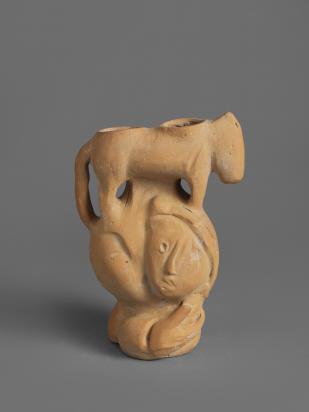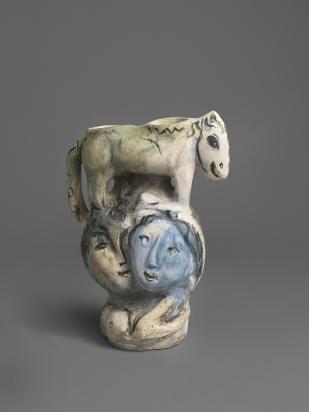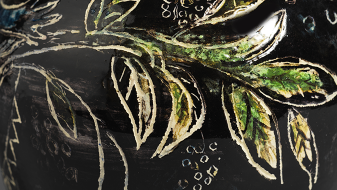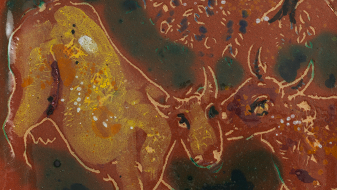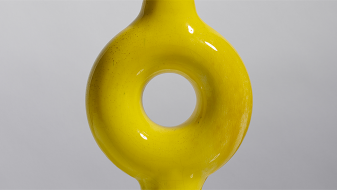In collaboration with the Madoura studio in Vallauris1, in 1957 Chagall made a series of anthropomorphic ceramics—four are known to exist—called The Lovers and the Beast. While, unlike Picasso, Chagall only created one-off pieces and no limited editions, he did produce several series of two to four shaped pieces, like this one.
The shape, reproduced using a mold, is common to all four works. Only two cavities attest to the piece’s utilitarian aspect. The foot of the vase features two breasts and a hand, while the belly has two heads topped by a neck shaped like an animal—probably a horse or a donkey, iconographic motifs recurrent in the artist's work. A hand, symbolizing the creative gesture, and a beast are also present on the Sculpted Vase [Vase sculpté] (1952). Here, the protective animal overhangs the rounded shape of the two heads,2 rising like a hill.
One of these “vase-sculptures”3 is a terracotta variation devoid of decoration. The other versions’ decoration and colors vary depending on the engobes, oxides and incisions in the raw clay. The material is unenameled, velvety and matte. The vase in the Marc Chagall National Museum in Nice features a dark engobe, with white highlights and warm tones enhancing the sketched faces of the figures. One of the two sides of the predominantly ochre version, like the blue one, features houses and a bell tower evoking the artist's native Vitebsk, recalling the symbolic dimension of earth for Chagall.4 He said: "I came to France with soil still on the roots of my shoes. It takes a long time for the earth to dry and fall off ... To keep the soil on your roots or to find other ones is a real miracle".5 Chagall cleverly played with forms and motifs, rendered differently and painted on different-colored backgrounds, allowing the works to be read in two ways: as both historiated vases and sculptures of animal and human creatures.
These four creations illustrate diverse sources of inspiration, including Russian art and crafts, such as utilitarian and decorative clay figurines and the hybrid beings in lubki.6 Chagall knew and liked the work of artist Anna Golubkina,7 who, in 1899, freely sculpted the material to depict the multiple faces on the vase Fog (marble, Tretyakov Gallery, Moscow). Bruno Gaudichon also pointed out the “resonances” between Chagall’s “works in volume” and pre-Hispanic ceramics.8 The double heads, which the artist liked to depict, of Tlatilco statuettes9 could have been of particular interest to him (he may have seen some during his trip to Mexico in 1942). Moreover, in 1955 an exhibition of pre-Colombian works10 was held at the Nérolium in Vallauris.11 A letter to collector Nathan Cummings about the exhibition of his collection at the Louvre in 195612 attests to Chagall’s interest in these works.13 It is not surprising, then, to see primitive-looking anthropomorphic and zoomorphic forms among his works, such as The Blue Donkey [L'Âne bleu] (1954),14 and this series, The Lovers and the Beast, evoking these ancestral ceramics.
Moreover, Chagall admired the works of Paul Gauguin (1848-1903) and paid tribute to him in a painting (Homage to Gauguin, 1956). Gauguin himself drew inspiration from pre-Hispanic ceramics, such as the portrait vases of the Mochica culture15 (Peru), when he created pieces like Self-Portrait and Vase Depicting Leda and the Swan (1887-1888), echoed by the two portraits of a two-headed being in the Lovers and the Beast series.
-
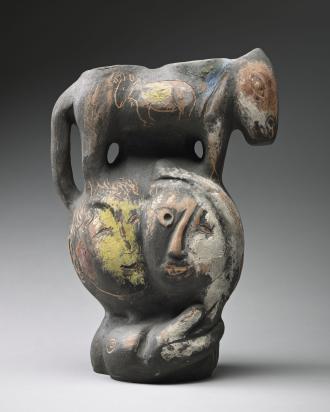
Marc CHAGALL, Lovers and the Beast (Les Amoureux et la Bête), 1957, red clay, decorated with slips and oxides, engraved with a dry point needle, 12 13/16 x 8 11/16 x 7 1/16 in. (32.5 x 22 x 18 cm), Musée national Marc Chagall, Nice © Adrien DIDIERJEAN, RMN-Grand Palais (Musée national Marc Chagall)/ADAGP, Paris, 2025
-
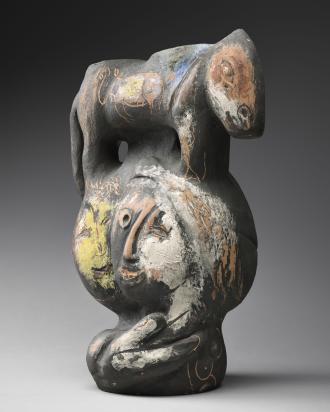
Marc CHAGALL, Lovers and the Beast (Les Amoureux et la Bête), 1957, red clay, decorated with slips and oxides, engraved with a dry point needle, 12 13/16 x 8 11/16 x 7 1/16 in. (32.5 x 22 x 18 cm), Musée national Marc Chagall, Nice © Adrien DIDIERJEAN, RMN-Grand Palais (Musée national Marc Chagall)/ADAGP, Paris, 2025
-
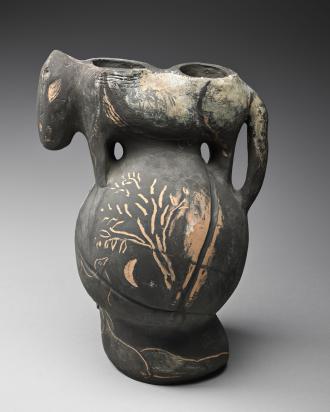
Marc CHAGALL, Lovers and the Beast (Les Amoureux et la Bête), 1957, red clay, decorated with slips and oxides, engraved with a dry point needle, 12 13/16 x 8 11/16 x 7 1/16 in. (32.5 x 22 x 18 cm), Musée national Marc Chagall, Nice © Adrien DIDIERJEAN, RMN-Grand Palais (Musée national Marc Chagall)/ADAGP, Paris, 2025
-
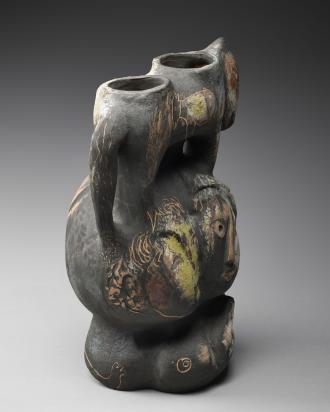
Marc CHAGALL, Lovers and the Beast (Les Amoureux et la Bête), 1957, red clay, decorated with slips and oxides, engraved with a dry point needle, 12 13/16 x 8 11/16 x 7 1/16 in. (32.5 x 22 x 18 cm), Musée national Marc Chagall, Nice © Adrien DIDIERJEAN, RMN-Grand Palais (Musée national Marc Chagall)/ADAGP, Paris, 2025
-
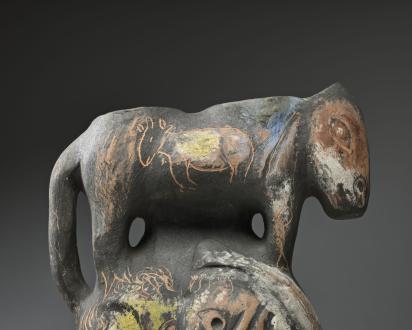
Marc CHAGALL, Lovers and the Beast (Les Amoureux et la Bête), 1957, red clay, decorated with slips and oxides, engraved with a dry point needle, 12 13/16 x 8 11/16 x 7 1/16 in. (32.5 x 22 x 18 cm), Musée national Marc Chagall, Nice © Adrien DIDIERJEAN, RMN-Grand Palais (Musée national Marc Chagall)/ADAGP, Paris, 2025
